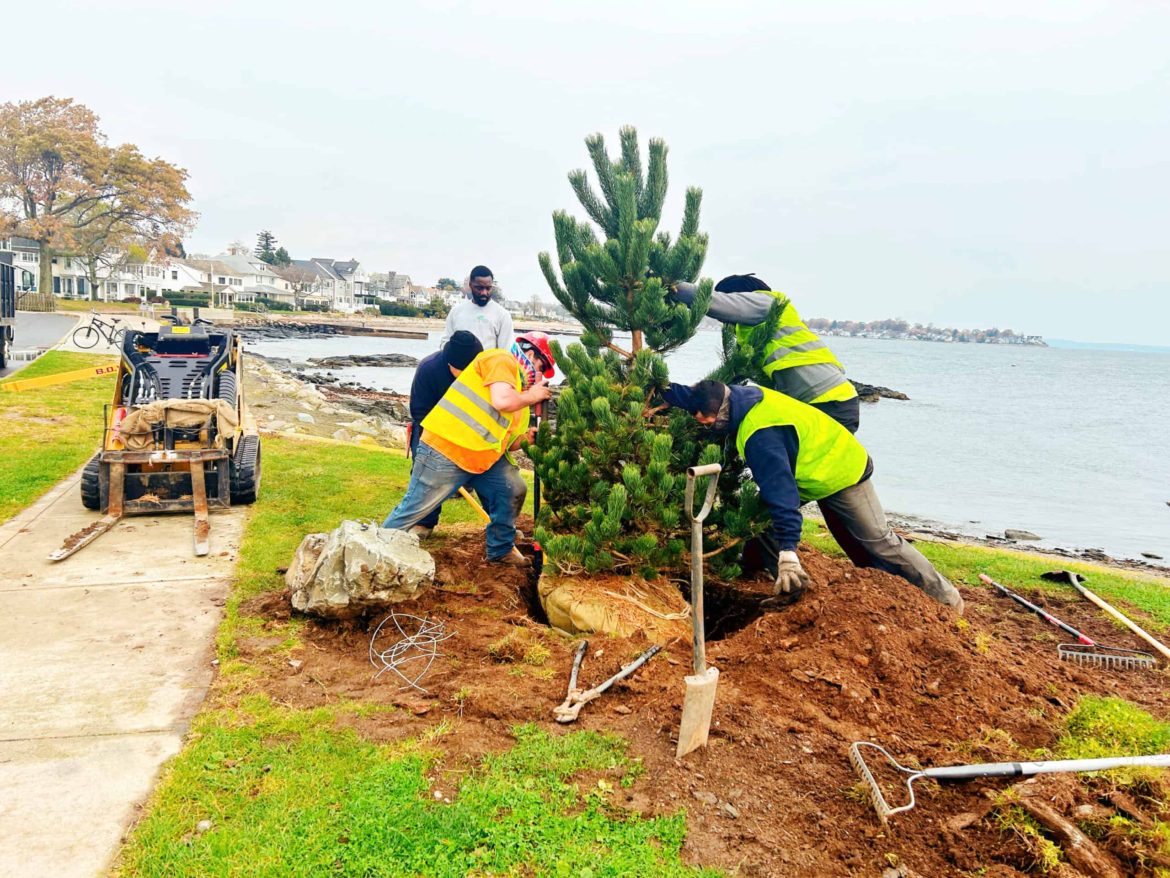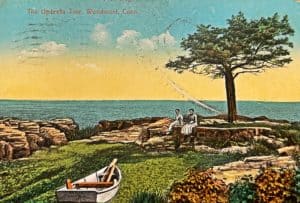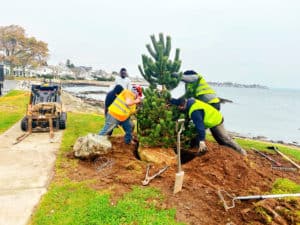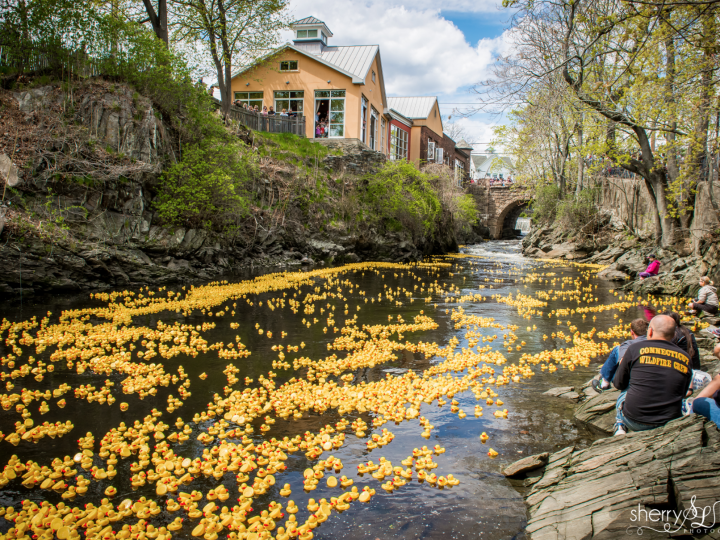
Katherine Krauss Murphy spread a dozen or more postcards on the dining room table in her Woodmont home; some in full color, some with colors that faded with age into a dusty sepia. All, however, depicted the same subject—a knotted trunk coated with bumpy, gray bark, topped with a haphazard mane of prickly pine needles.
Known colloquially as the “Umbrella Tree,” one of multiple versions of it has provided shade over a small patch of land extending into Long Island Sound for more than a century.
“I’m obsessed with that. I’m always finding postcards,” Murphy says, holding one that depicts a couple sitting under the Umbrella Tree, a rowboat in the foreground. “I mean, nobody needs this many postcards of one tree.”
That so many postcards have been produced featuring the charming tree may suggest its special nature and significance to Woodmont’s culture. That may be why, when it was learned that the beloved tree was dying and in need of replacement, the news rocked the borough, where the tree is a focal point for the many people who walk, jog, and bike along Beach Avenue every day.
A press release from Borough Warden Ed Bonessi, Jr., said the Umbrella Tree “…has been given a terminal diagnosis by several licensed arborists.” In fact, Bonessi first noticed that the tree was ill some five years ago. He and the burgesses spent years seeking to remedy it. “I was literally sitting on my porch, and I was looking over and I’m noticing that some of the needles started to turn yellow,” he says.
The borough reached out to an arborist, who said that while the tree was dying, some steps could be taken to slow the process. They drilled small holes into the base of the tree, then installed eight “IV”-type bottles into it that fed the tree nutrients and fungicide, Bonessi said. “I don’t know if it really helped or not. But I just noticed it was getting progressively worse,” Bonessi recalls.
An arborist he contacted for a second opinion told him one wasn’t necessary. And, that a replacement was.
Murphy, a historian whose book, Woodmont (Past and Present) mentions the Umbrella Tree, said the origin of the first tree might have been lost to history. “The earliest postcards that I have of the tree are from 1905 or 1906,” she says. “It had a name and everything by the early 1900s.” That, plus a 1907 postcard depicting the tree as mature, led her to guess it might have been planted sometime in the 1890s.
But why? Murphy’s research has turned up nothing definitive.
Pure conjecture, according to Murphy, is that it could have been installed as a tourist destination. Around the turn of the 20th century, Woodmont was fast becoming a popular vacation spot and the two homes that still stand across the street from the Umbrella Tree served as inns. It’s possible, she said, that one of those innkeepers installed the tree to beautify the area and attract business.
What’s known is that the first tree, known as a Cedar of Lebanon, lived in that spot along Beach Avenue until the summer of 1954, when it was destroyed by Hurricane Edna.
The borough soon replaced it with a black pine tree, and that’s the one that stood there for almost 70 years, well past the species’ life expectancy of 25-30 years.
Over time, the Umbrella Tree became an enduring symbol of Woodmont. It’s not uncommon to see people reading, picnicking, or exercising underneath it, even in the colder weather. Couples often get engaged there. Some said loved ones have even scattered cremains into the waters of Long Island Sound from there.
Kelly Cummings, who has lived in Woodmont almost 25 years, said she’s glad the Umbrella Tree will be replaced. “It’s one of those symbols of, for me, community,” she says. “I think just having something so recognizable and so familiar that you see on a daily basis seems like it makes it like home.”
The tree is a common point of reference for the folks who pass by it on their shoreline strolls says Cummings. “I’ve always found it very peaceful to just sit and look out at the water. It’s kind of like a little meditation spot there.”
As the Umbrella Tree neared the end of its life, Bonessi said he knew the residents of Woodmont would take the news hard. “We actually took some pinecones from it because we had this crazy notion of possibly doing like a cloning,” he says. It’s not that far-fetched an idea, he adds, pointing out a similar, much healthier black pine just up the road in front of 108 Beach Avenue that’s an obvious spawn of an errant pinecone from the Umbrella Tree.
“We thought…maybe we can, you know, sort of replicate that in that in a laboratory situation. Then we knew we would have to plant it somewhere and nurture it,” Bonessi explains. “We had that idea for about a year-and-a-half or two years, and the seeds actually didn’t take the way we thought they were going to take.”
That’s when it was decided to replace the tree.
With the approval of city Tree Warden Steve Johnson, the Umbrella Tree was removed on October 31, 2023. On November 7th, crews from the Milford-based Northeast Horticultural Services installed in its place an Oregon green pine, which is similar aesthetically, but hardier.
According to Johnson, for several years the new Umbrella Tree will look more like a bush. The borough is investigating measures to keep the curious public from hindering its growth.
The death and replacement of the Umbrella Tree is one of several major changes to historic Woodmont that Bonessi, as warden, has weathered in recent years. In 2018, a fire decimated the popular seafood restaurant Scribner’s, and this past summer, the remains were demolished along with a small, brick former Post Office to make way for a planned mixed-use development.
A couple of years later, the historic flagpole on Signal Rock, which historians claim was made from the mast of a 19th-century whaling ship, was found to be rotted beyond repair and replaced with one made of fiberglass.
“The shoreline, our coastal area in Woodmont, is the reason why Woodmont became Woodmont back in the 1800s because it was so beautiful and iconic,” Bonessi says. “It’s been through so many different generations. I’m just trying to preserve it. I don’t want to I wouldn’t say replace; I want to say preserve.”
—Mike Patrick




